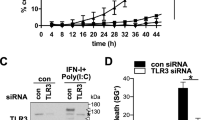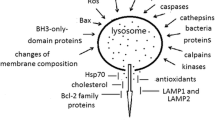Abstract
Livin is a member of the Inhibitor of Apoptosis Protein family which inhibits apoptosis induced by a variety of stimuli. We previously identified Livin and demonstrated that following apoptotic stimuli, Livin is cleaved by effector caspases to produce a truncated form with paradoxical pro-apoptotic activity. In the present study, we reveal that while full-length Livin shows diffuse cytoplasmic localization, truncated Livin (tLivin) is found in a peri-nuclear distribution with marked localization to the Golgi apparatus. Using mutation analysis, we identified two domains that are crucial for the pro-apoptotic activity of tLivin: the N-terminal region of tLivin which is exposed by cleavage, and the RING domain. We demonstrate that, of the N-terminal sequence, only the first N-terminal glycine residue dictates the peri-nuclear distribution of tLivin. However, while the perinuclear localization of tLivin is essential, it is not sufficient for tLivin to exert its pro-apoptotic function. Once tLivin is properly localized, an intact RING domain enables its pro-apoptotic function.










Similar content being viewed by others
Abbreviations
- IAP:
-
inhibitor of apoptosis
References
Salvesen GS, Duckett CS (2002) IAP proteins: blocking the road to death's door. Nat Rev Mol Cell Biol 3:401–410
Borden KL (2000) RING domains: master builders of molecular scaffolds? J Mol Biol 295:1103–1112
Chai J, Shiozaki E, Srinivasula SM et al (2001) Structural basis of caspase-7 inhibition by XIAP. Cell 104:769–780
Huang Y, Park YC, Rich RL, Segal D, Myszka DG, Wu H (2001) Structural basis of caspase inhibition by XIAP: differential roles of the linker versus the BIR domain. Cell 104:781–790
Riedl SJ, Renatus M, Schwarzenbacher R et al (2001) Structural basis for the inhibition of caspase-3 by XIAP. Cell 104:791–800
Hegde R, Srinivasula SM, Zhang Z et al (2002) Identification of Omi/HtrA2 as a mitochondrial apoptotic serine protease that disrupts inhibitor of apoptosis protein-caspase interaction. J Biol Chem 277:432–438
Wright CW, Duckett CS (2005) Reawakening the cellular death program in neoplasia through the therapeutic blockade of IAP function. J Clin Invest 115:2673–2678
Nachmias B, Ashhab Y, Ben-Yehuda D (2004) The inhibitor of apoptosis protein family (IAPs): an emerging therapeutic target in cancer. Semin Cancer Biol 14:231–243
Xiang Y, Yao H, Wang S et al (2006) Prognostic value of Survivin and Livin in nasopharyngeal carcinoma. Laryngoscope 116:126–130
Kim DK, Alvarado CS, Abramowsky CR et al (2005) Expression of inhibitor-of-apoptosis protein (IAP) livin by neuroblastoma cells: correlation with prognostic factors and outcome. Pediatr Dev Pathol 8:621–629
Tanabe H, Yagihashi A, Tsuji N, Shijubo Y, Abe S, Watanabe N (2004) Expression of survivin mRNA and livin mRNA in non-small-cell lung cancer. Lung Cancer 46:299–304
Nachmias B, Ashhab Y, Bucholtz V et al (2003) Caspase-mediated cleavage converts Livin from an antiapoptotic to a proapoptotic factor: implications for drug-resistant melanoma. Cancer Res 63:6340–6349
Ashhab Y, Alian A, Polliack A, Panet A, Ben Yehuda D (2001) Two splicing variants of a new inhibitor of apoptosis gene with different biological properties and tissue distribution pattern. FEBS Lett 495:56–60
Lin JH, Deng G, Huang Q, Morser J (2000) KIAP, a novel member of the inhibitor of apoptosis protein family. Biochem Biophys Res Commun 279:820–831
Kasof GM, Gomes BC (2001) Livin, a novel inhibitor of apoptosis protein family member. J Biol Chem 276:3238–3246
Vucic D, Stennicke HR, Pisabarro MT, Salvesen GS, Dixit VM (2000) ML-IAP, a novel inhibitor of apoptosis that is preferentially expressed in human melanomas. Curr Biol 10:1359–1366
Deveraux QL, Leo E, Stennicke HR, Welsh K, Salvesen GS, Reed JC (1999) Cleavage of human inhibitor of apoptosis protein XIAP results in fragments with distinct specificities for caspases. Embo J 18:5242–5251
Johnson DE, Gastman BR, Wieckowski E et al (2000) Inhibitor of apoptosis protein hILP undergoes caspase-mediated cleavage during T lymphocyte apoptosis. Cancer Res 60:1818–1823
Clem RJ, Sheu TT, Richter BW et al (2001) c-IAP1 is cleaved by caspases to produce a proapoptotic C-terminal fragment. J Biol Chem 276:7602–7608
Porgador A, Mandelboim O, Restifo NP, Strominger JL (1997) Natural killer cell lines kill autologous beta2-microglobulin-deficient melanoma cells: implications for cancer immunotherapy. Proc Natl Acad Sci USA 94:13140–13145
Mandelboim O, Reyburn HT, Vales-Gomez M et al (1996) Protection from lysis by natural killer cells of group 1 and 2 specificity is mediated by residue 80 in human histocompatibility leukocyte antigen C alleles and also occurs with empty major histocompatibility complex molecules. J Exp Med 184:913–922
Yim H, Jin YH, Park BD, Choi HJ, Lee SK (2003) Caspase-3-mediated cleavage of Cdc6 induces nuclear localization of p49-truncated Cdc6 and apoptosis. Mol Biol Cell 14:4250–4259
Gleeson PA (1998) Targeting of proteins to the Golgi apparatus. Histochem Cell Biol 109:517–532
Munro S (1998) Localization of proteins to the Golgi apparatus. Trends Cell Biol 8:11–15
Nicholson DW (1999) Caspase structure, proteolytic substrates, and function during apoptotic cell death. Cell Death Differ 6:1028–1042
Zha J, Weiler S, Oh KJ, Wei MC, Korsmeyer SJ (2000) Posttranslational N-myristoylation of BID as a molecular switch for targeting mitochondria and apoptosis. Science 290:1761–1765
Utsumi T, Sakurai N, Nakano K, Ishisaka R (2003) C-terminal 15 kDa fragment of cytoskeletal actin is posttranslationally N-myristoylated upon caspase-mediated cleavage and targeted to mitochondria. FEBS Lett 539:37–44
Bennett M, Macdonald K, Chan SW, Luzio JP, Simari R, Weissberg P (1998) Cell surface trafficking of Fas: a rapid mechanism of p53-mediated apoptosis. Science 282:290–293
Hicks SW, Machamer CE (2005) Golgi structure in stress sensing and apoptosis. Biochim Biophys Acta 1744:406–414
Mancini M, Machamer CE, Roy S et al (2000) Caspase-2 is localized at the Golgi complex and cleaves golgin-160 during apoptosis. J Cell Biol 149:603–612
Hauser HP, Bardroff M, Pyrowolakis G, Jentsch S (1998) A giant ubiquitin-conjugating enzyme related to IAP apoptosis inhibitors. J Cell Biol 141:1415–1422
Bartke T, Pohl C, Pyrowolakis G, Jentsch S (2004) Dual role of BRUCE as an antiapoptotic IAP and a chimeric E2/E3 ubiquitin ligase. Mol Cell 14:801–811
Plenchette S, Cathelin S, Rebe C et al (2004) Translocation of the inhibitor of apoptosis protein c-IAP1 from the nucleus to the Golgi in hematopoietic cells undergoing differentiation: a nuclear export signal-mediated event. Blood 104:2035–2043
Hay BA, Wassarman DA, Rubin GM (1995) Drosophila homologs of baculovirus inhibitor of apoptosis proteins function to block cell death. Cell 83:1253–1262
Suzuki Y, Nakabayashi Y, Takahashi R (2001) Ubiquitin-protein ligase activity of X-linked inhibitor of apoptosis protein promotes proteasomal degradation of caspase-3 and enhances its anti-apoptotic effect in Fas-induced cell death. Proc Natl Acad Sci USA 98:8662–8667
MacFarlane M, Merrison W, Bratton SB, Cohen GM (2002) Proteasome-mediated degradation of Smac during apoptosis: XIAP promotes Smac ubiquitination in vitro. J Biol Chem 277:36611–36616
Hu S, Yang X (2003) Cellular inhibitor of apoptosis 1 and 2 are ubiquitin ligases for the apoptosis inducer Smac/DIABLO. J Biol Chem 278:10055–10060
Acknowledgments
We thank D. Rund for critical reading of the manuscript. We thank M Tharshis. This work was supported by the Caesarea Edmond Benjamin De Rothschild Foundation.
Author information
Authors and Affiliations
Corresponding author
Electronic Supplementary Material
Rights and permissions
About this article
Cite this article
Nachmias, B., Lazar, I., Elmalech, M. et al. Subcellular localization determines the delicate balance between the anti- and pro-apoptotic activity of Livin. Apoptosis 12, 1129–1142 (2007). https://doi.org/10.1007/s10495-006-0049-1
Published:
Issue Date:
DOI: https://doi.org/10.1007/s10495-006-0049-1




